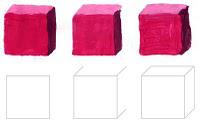 The California Standards of Visual Arts recommends that 4th graders learn to “use shading to transform a two-dimensional shape into a three-dimensional form”. This exercise fills the bill.1. I gave students paper 18" x 8" long, and a 3" cardboard square template. I asked them to trace one square in the middle of the paper, and then one to the right and one to the left.
The California Standards of Visual Arts recommends that 4th graders learn to “use shading to transform a two-dimensional shape into a three-dimensional form”. This exercise fills the bill.1. I gave students paper 18" x 8" long, and a 3" cardboard square template. I asked them to trace one square in the middle of the paper, and then one to the right and one to the left.2. Using the steps shown in the diagram, they were to make 45 degree angles to the right of each corner, all in the same direction and the same length. When they connected the ends of all the angles, they should have 3 squares that look like cubes.
3. Each student got a paper plate, brush and dab of black and white paint. They were then able to choose one main color (I gave them 3 choices). I asked that they paint all the fronts of the cubes with just the straight, main color. Next they could make a “tint”, by adding white, and paint it on the tops of all 3 cubes. And lastly, they could make a “shade” by adding a little black to the color and filling in the remaining right side. I plan to have the students cut their cubes out next week and mount them on colored paper. This was a relief for some students who were worried about wiggly lines and spots that they accidentally got on their paper.
CA Visual Art Standard: Creative Expression, Grade Four
2.2 Mix and apply tempera paints to create tints, shades, and neutral colors.
